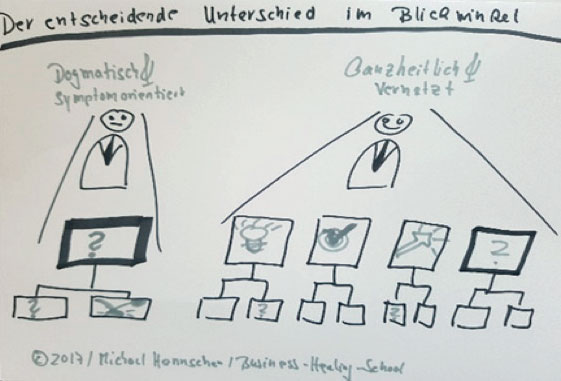Current discussions around so-called trend topics such as agile organisations or agile methods unfortunately repeatedly point out typical undesirable developments in some respects. The fundamentals that are hidden in the approaches are sold as a „new miracle cure“. During introduction and implementation, these are then backed by the organisations like a mantra. Three aspects are therefore of fundamental importance in the integration of „trend topics“:
Every child needs a new name. The agile mindset includes methods that have been used in management and organisations for many years. We first encountered networked and flexible team developments, or iterative approaches, in combination with structured procedures in 2002¹. In large-scale programs these were successfully implemented without the need for a new name.
There is a great danger of unilaterally dedicating efforts to a new trendy „management philosophy“. Especially in larger organisations this new category is opened, consultants are engaged, and, for example, agile methods are sold as the new miracle cure. If consulting companies that have worked their way into the organisation through the new trend management methods are also involved, further undesirable developments may occur. After all, it is quite possible that neither to the left nor to the right of the new category is anything accepted or integrated. It is therefore important to be aware that people tend to think in stereotypes. Category sorting provides security!
This human desire for safety and standardized approaches can ultimately have exactly the opposite effect even with well-intentioned, new creative approaches. If a negative pattern of „too much of the good“ or „more of the same“ was already present in the organisation beforehand, there is considerable danger that valuable structures and processes worthy of preservation will be completely destroyed. Have you not experienced this yourself? You have just laboriously built up a new and stable system and then comes the call: „But now please turn left again“.
Therefore, our advice is always to take a holistic approach first. The graphic illustrates this.

In a symptom-oriented approach it is similar to a visit to the doctor: the focal point is the symptom. The result is usually a tried-and-tested approach with a medication that combats the symptom. In a holistic approach you look beyond the symptom. Ultimately, you widen your view because you focus on the complexity of the interrelationships.
In this way, it is possible that good approaches, as is the case with agile methods, result in a framework that is too rigid because it mutates into an inner rigid principle of faith. For example, if someone has previously had radical thinking with an „either/or“ mentality, there is a high risk that this one-sided mentality will also be used with an agile method.
We experience this again and again when the “knights of faith“ clash and it is our task to get people into a common mode of work. Creative „as-well-as-thinking“ is then a key tool in the new process. With the integrated holistic approach and a systemic-dynamic-creative methodology, the important topics are networked and sustainably solved. And thus, in organisational design precisely tailored to the culture and to the developmental maturity. There are three simple questions to start with:
What has been excellent so far and should absolutely be maintained?
What is „o.k.“ so far and should be adjusted, changed or improved?
What absolutely needs to be changed?
¹ Doppler, Klaus; Lauterburg, Christoph: Change Management.
Den Unternehmenswandel gestalten. Frankfurt/New
York: Campus. 10. Aufl. 2002. p. 55.
